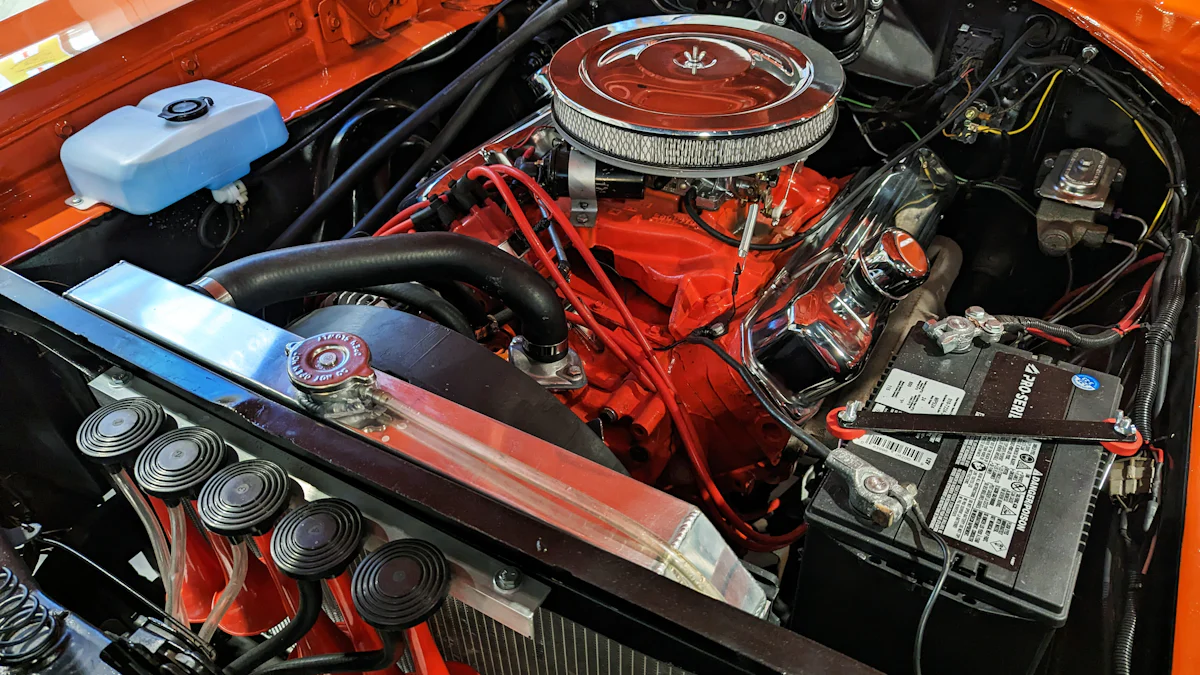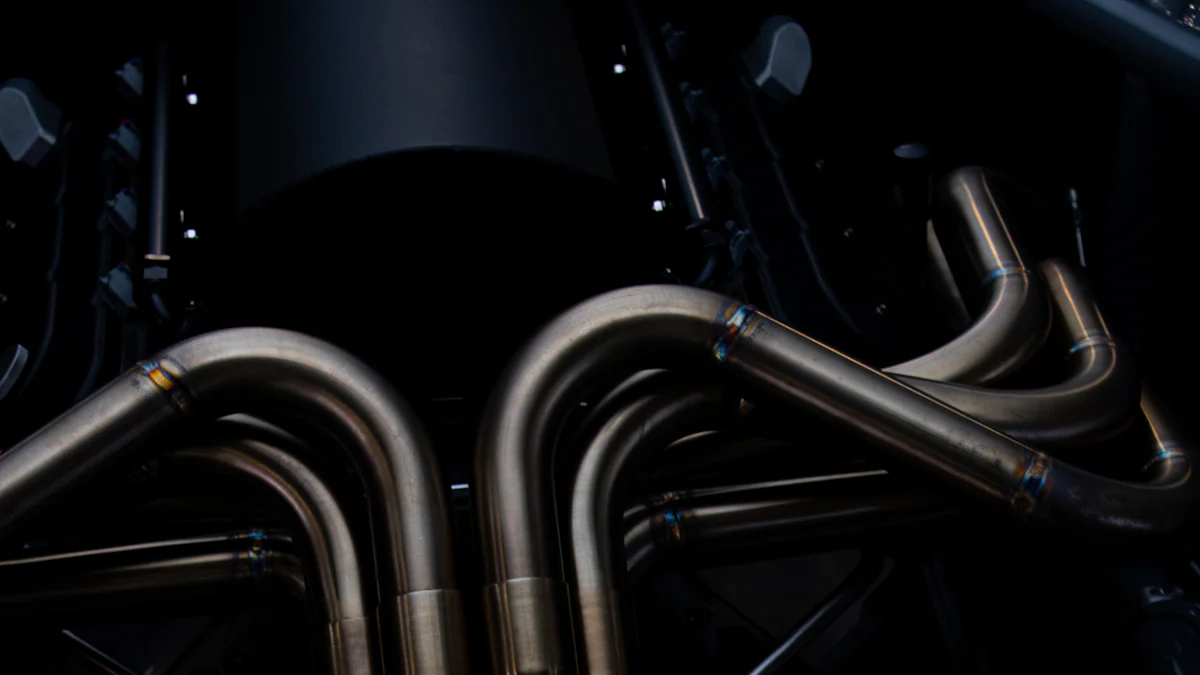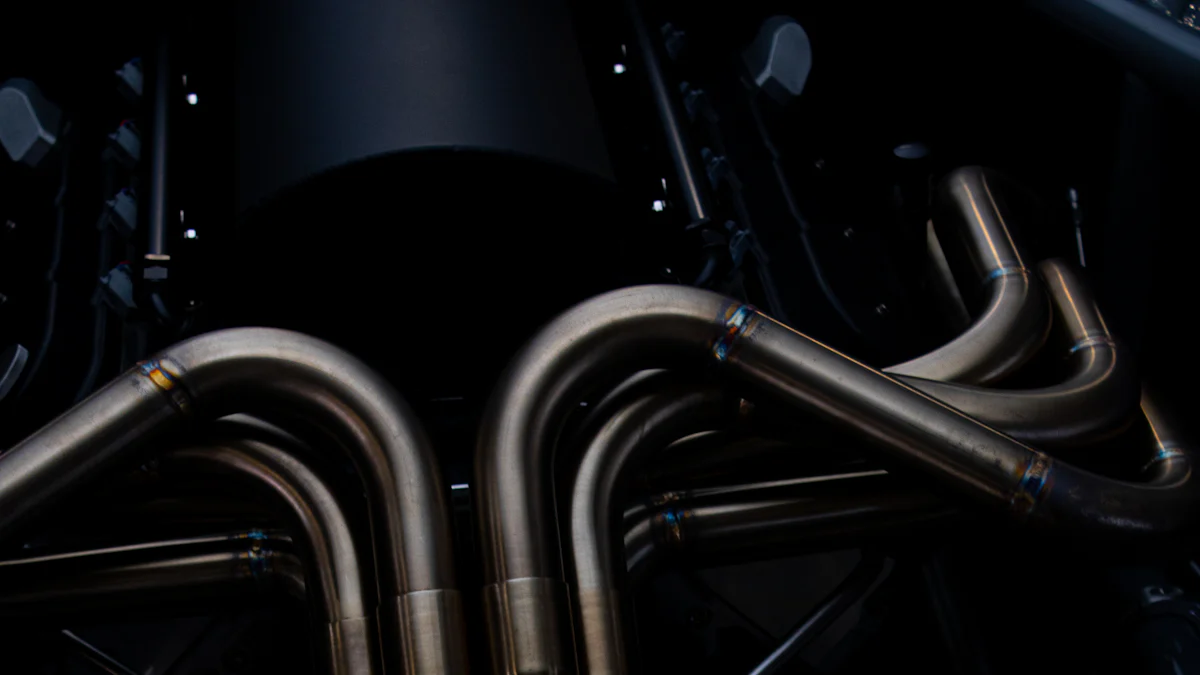
When it comes to optimizing the performance of marine exhaust manifolds for Chevy 350 engines, understanding their significance is paramount. These manifolds play a crucial role in managing engine heat efficiently and ensuring smooth operation. Considering the lifespan of marine exhaust manifolds, which ranges from 6 to 8 years under normal conditions, proper maintenance becomes essential. This blog provides insights into the importance of these components, sheds light on the Chevy 350 engines’ overview, and aims to guide readers on selecting the best marine exhaust manifolds for optimal engine functionality.
Top Brands for Marine Exhaust Manifolds

GLM Marine
Features
- GLM Marine offers a wide range of marine exhaust manifolds specifically designed for Chevy 350 engines.
- The manifolds are crafted with precision engineering to ensure optimal performance and durability.
- Each manifold undergoes rigorous testing to meet industry standards and deliver reliable operation.
- With a focus on quality and innovation, GLM Marine stands out as a trusted brand in the marine industry.
Benefits
- Enhanced Performance: The marine exhaust manifolds from GLM Marine are engineered to improve engine efficiency and power output.
- Durability: Constructed from high-quality materials, these manifolds are built to withstand harsh marine conditions.
- Corrosion Resistance: The specialized coatings on the manifolds provide excellent protection against corrosion, extending their lifespan.
- Easy Installation: Designed for seamless integration, GLM Marine manifolds offer straightforward installation processes.
Barr Marine
Features
- Barr Marine excels in providing premium marine exhaust manifolds tailored for Chevy 350 engines.
- The brand’s commitment to excellence is reflected in the superior craftsmanship of each manifold.
- Barr Marine prioritizes performance, reliability, and longevity in all its products.
Benefits
- Optimized Engine Functionality: Barr Marine manifolds are optimized to enhance the overall performance of Chevy 350 engines.
- Longevity: With a focus on durability, these manifolds are built to last, ensuring prolonged use without compromising quality.
- Efficient Cooling: The design of Barr Marine exhaust manifolds facilitates efficient cooling of the engine, preventing overheating issues.
- Cost-Effective Solution: Despite their high quality, Barr Marine manifolds offer cost-effective solutions for marine enthusiasts.
Sierra
Features
- Sierra is renowned for its comprehensive range of high-performance marine exhaust manifolds suitable for Chevy 350 engines.
- The brand combines cutting-edge technology with expert craftsmanship to deliver top-notch products that meet customer expectations.
Benefits
- Reliability: Sierra’s marine exhaust manifolds are known for their reliability under demanding marine conditions, ensuring consistent performance.
- Compatibility: These manifolds are designed to seamlessly integrate with Chevy 350 engines, offering a perfect fit and hassle-free installation process.
- Enhanced Durability: Sierra utilizes advanced materials that enhance the durability and longevity of their exhaust manifolds.
- Performance Boost: Installing Sierra’s marine exhaust manifolds can result in a noticeable improvement in engine performance and efficiency.
Volvo Penta
Features
- Volvo Penta presents a diverse selection of high-quality marine exhaust manifolds tailored for Chevy 350 engines.
- Crafted with precision and expertise, these manifolds ensure optimal performance and longevity.
- The design of Volvo Penta manifolds prioritizes efficiency and durability to meet the demands of marine environments.
- Each manifold undergoes rigorous testing to guarantee reliability and seamless operation.
Benefits
- Enhanced Performance: Installing Volvo Penta marine exhaust manifolds can significantly boost the efficiency and power output of Chevy 350 engines.
- Longevity: With a focus on durability, these manifolds are built to withstand harsh marine conditions, ensuring prolonged use without compromising quality.
- Corrosion Resistance: The specialized coatings on Volvo Penta manifolds provide exceptional protection against corrosion, extending their lifespan.
- Easy Maintenance: Designed for hassle-free maintenance, Volvo Penta manifolds offer straightforward cleaning and care procedures.
Material Options for Marine Exhaust Manifolds
Cast Iron
In the realm of marine exhaust manifolds for Chevy 350 engines, the choice of material holds significant importance. Cast Iron stands out as a traditional yet reliable option for manifold construction, offering a blend of durability and cost-effectiveness that appeals to many marine enthusiasts.
Durability
The inherent strength of Cast Iron makes it a preferred material for marine exhaust manifolds due to its ability to withstand high temperatures and harsh marine environments. The robust nature of cast iron ensures longevity and consistent performance, making it a practical choice for engine components that endure extreme conditions.
Cost
When considering the financial aspect, Cast Iron emerges as a cost-effective solution for marine exhaust manifolds. Its affordability compared to other materials does not compromise its durability or functionality, providing boat owners with a reliable and budget-friendly option for their Chevy 350 engines.
Aluminum
On the opposite end of the spectrum lies Aluminum, a lightweight alternative that offers unique advantages in terms of weight reduction and performance enhancement for marine exhaust manifolds.
Weight
The main advantage of Aluminum over Cast Iron is its significantly lower density, translating to a lighter weight that can benefit overall vessel performance. The reduced weight of Aluminum components contributes to improved fuel efficiency and maneuverability, making it an attractive choice for those seeking enhanced agility on the water.
Performance
Beyond its weight-saving properties, Aluminum excels in boosting engine performance by facilitating quicker acceleration and higher speeds. The lightweight nature of Aluminum components reduces strain on the engine, leading to optimized power output and smoother operation during marine excursions.
Stainless Steel
For boat owners prioritizing corrosion resistance and longevity in their marine exhaust manifolds, Stainless Steel emerges as a top-tier material known for its exceptional durability and resilience against harsh marine conditions.
Corrosion Resistance
One of the standout features of Stainless Steel is its superior resistance to corrosion, making it an ideal choice for marine environments where exposure to saltwater can accelerate metal degradation. The protective properties of Stainless Steel ensure long-term reliability and minimal maintenance requirements, enhancing the lifespan of exhaust manifolds.
Longevity
Boasting impressive longevity characteristics, Stainless Steel exhaust manifolds offer extended service life compared to other materials like Cast Iron or Aluminum. The robust nature of Stainless Steel components ensures sustained performance over time, reducing the need for frequent replacements and maintenance tasks associated with inferior materials.
By carefully considering the material options available for marine exhaust manifolds—whether opting for durable Cast Iron, lightweight Aluminum, or corrosion-resistant Stainless Steel—boat owners can make informed decisions that align with their specific needs and preferences.
Installation Tips for Marine Exhaust Manifolds

Preparation
When preparing to install marine exhaust manifolds for Chevy 350 engines, it is essential to gather the necessary tools and adhere to safety precautions to ensure a smooth and successful installation process.
Tools Needed
- Socket Wrench Set: A socket wrench set with various sizes will be required to loosen and tighten bolts efficiently.
- Torque Wrench: Utilizing a torque wrench is crucial for achieving the recommended torque specifications during installation.
- Gasket Sealant: Having a high-quality gasket sealant on hand will help create a secure seal between the manifold and the engine block.
- Safety Gloves and Goggles: Prioritize safety by wearing protective gloves and goggles to prevent injuries during the installation process.
Safety Precautions
- Ventilation: Ensure proper ventilation in the workspace to prevent inhalation of harmful fumes emitted during installation.
- Secure Support: Use sturdy supports or blocks to secure the boat’s engine in place before beginning the installation.
- Cool Engine: Allow the engine to cool down before handling the exhaust manifolds to avoid burns or injuries.
- Fire Extinguisher: Have a fire extinguisher nearby as a precautionary measure in case of any unexpected incidents.
Step-by-Step Guide
Following a systematic approach when replacing marine exhaust manifolds is crucial for a successful installation that optimizes engine performance.
Removing Old Manifold
- Locate Manifold: Identify the existing exhaust manifold on your Chevy 350 engine.
- Disconnect Components: Carefully disconnect all hoses, bolts, and connections attached to the old manifold.
- Remove Bolts: Loosen and remove the bolts securing the manifold in place using a socket wrench set.
- Detach Manifold: Gently detach the old manifold from the engine block, ensuring no components are left behind.
Installing New Manifold
- Clean Surface: Thoroughly clean the mounting surface on the engine block where the new manifold will be installed.
- Apply Sealant: Apply a thin layer of gasket sealant on both sides of the new manifold gasket for optimal sealing.
- Position Manifold: Carefully position the new marine exhaust manifold onto the engine block, aligning it with bolt holes.
- Secure Bolts: Gradually tighten and torque down all bolts using a torque wrench according to manufacturer specifications.
Torque Specifications
Understanding and adhering to proper torque specifications is paramount when installing marine exhaust manifolds to prevent leaks or damage over time.
Importance
Accurate torque application ensures that each bolt secures the manifold tightly without under or over-tightening, maintaining an effective seal against exhaust gases.
Recommended Values
- For 3/8 fasteners commonly used in marine exhaust manifolds, aim for a torque range between 20-25 Lb-Ft as recommended by manufacturers.
- Follow specific torque values provided by your chosen brand or refer to Chevy 350 engine manuals for precise torque requirements based on material type.
By following these comprehensive installation tips, boat owners can successfully replace marine exhaust manifolds for their Chevy 350 engines with precision and care, ensuring optimal performance and longevity of their marine vessels.
Maintenance Tips for Marine Exhaust Manifolds
Regular Inspections
What to Look For
- Visible Corrosion: Check for any signs of corrosion on the surface of the marine exhaust manifolds. Corrosion can weaken the material and lead to potential leaks or failures, impacting engine performance.
- Cracks or Holes: Inspect the manifolds thoroughly for any cracks or holes that may have developed over time. These structural damages can result in exhaust leaks and should be addressed promptly.
- Loose Fasteners: Ensure all fasteners securing the manifolds are tightened securely. Loose bolts can cause vibrations and compromise the seal between the manifold and the engine block.
- Water Leaks: Look for any indications of water leaks around the connections of the exhaust manifolds. Water leaks can indicate a failing gasket or a crack in the manifold, requiring immediate attention.
Frequency
- Monthly Inspections: Conduct visual inspections of marine exhaust manifolds at least once a month to catch any early signs of damage or wear.
- Pre-season Check: Before each boating season, perform a comprehensive inspection of the exhaust system, including manifolds, to ensure they are in optimal condition for extended use.
- Post-use Examination: After each boating trip, inspect the exhaust manifolds for any new developments such as discoloration, unusual odors, or abnormal sounds that may indicate underlying issues.
Cleaning and Care
Methods
- Routine Cleaning: Regularly clean the exterior surfaces of marine exhaust manifolds using mild soap and water to remove salt deposits and dirt accumulation. Avoid using abrasive cleaners that can damage protective coatings.
- Internal Flushing: Periodically flush out internal passages of the manifolds with fresh water to eliminate salt build-up and prevent blockages that could impede proper water circulation.
- Heat Cycling: Allow marine exhaust manifolds to cool down naturally after use before rinsing with cold water. This heat cycling process helps prevent thermal shock and extends the longevity of the components.
- Professional Inspection: Consider engaging professional services for thorough cleaning and inspection of marine exhaust manifolds annually to detect hidden issues early on.
Products
- Use marine-grade stainless steel cleaners to maintain shine and protect against corrosion on stainless steel marine exhaust manifolds.
- Apply anti-corrosion sprays or coatings specifically designed for aluminum components to safeguard against oxidation and prolong their lifespan.
- Utilize high-temperature paint suitable for cast iron surfaces to touch up any areas where paint has worn off due to heat exposure.
- Invest in quality gaskets made from durable materials like graphite or multi-layered steel to ensure proper sealing between exhaust components.
Replacing Worn Parts
Signs of Wear
- Excessive Rust: If significant rust is present on marine exhaust manifolds despite regular maintenance, it may indicate material degradation requiring replacement.
- Deteriorated Gaskets: Crumbling or leaking gaskets between manifold joints suggest wear and tear that can compromise sealing effectiveness.
- Reduced Performance: Noticeable decreases in engine power output or efficiency could stem from worn-out components within the exhaust system.
- Unusual Noises: Strange noises emanating from the vicinity of marine exhaust manifolds during engine operation signal potential issues demanding attention.
Replacement Process
- Begin by identifying which specific parts require replacement based on visual inspections and diagnostic assessments conducted by experienced professionals.
- Source high-quality replacement parts from reputable manufacturers specializing in marine exhaust systems compatible with Chevy 350 engines.
- Follow manufacturer guidelines meticulously when installing new parts, ensuring correct alignment, torque specifications, and sealing procedures are adhered to precisely.
- Conduct post-installation checks by running engine tests under controlled conditions to verify proper functionality before resuming regular use on waterways.
Recapping the essential aspects of selecting marine exhaust manifolds for Chevy 350 engines is crucial for optimal performance. Considering the durability and cost-effectiveness of materials like Cast Iron and Aluminum, boat owners can make informed decisions based on their specific needs. The unique corrosion resistance properties of Stainless Steel offer longevity and reliability in harsh marine environments. For those prioritizing performance and efficiency, choosing the right manifold tailored to their engine requirements is paramount. Make a wise selection to ensure smooth sailing and prolonged engine functionality.
Post time: Jun-17-2024



